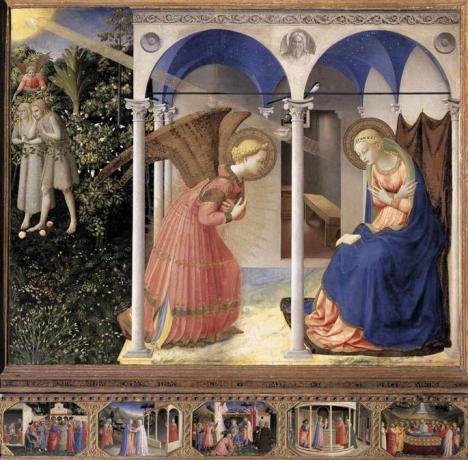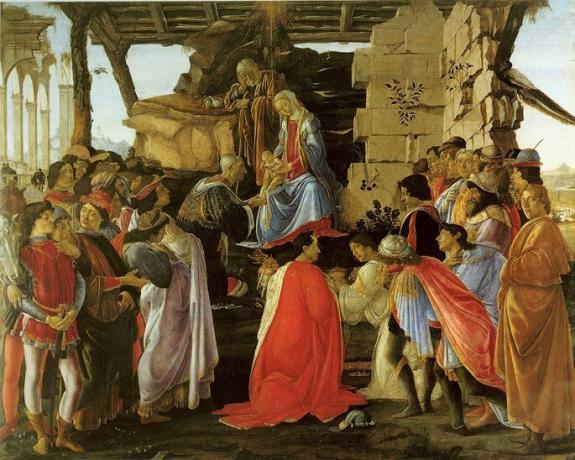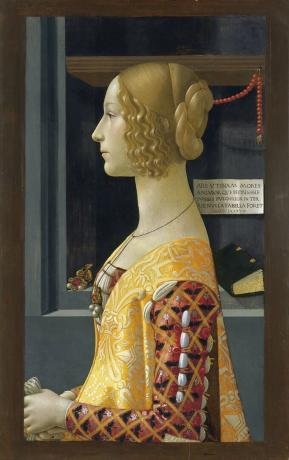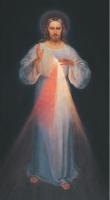The 25 most representative paintings of the Renaissance to understand their contributions
The great pictorial revolution of the Renaissance took place concretely in the 15th century, known as the Quattrocento. In an environment of growing intellectual curiosity, the improvement and diffusion of oil painting allowed the use of the canvas as a support, so that the painting could free itself from the walls, and this favored collecting particular.
Thus, new genres such as portraiture were created and interest in landscape and still life was born, although not yet as independent genres. The nudes and non-Christian mythological, historical and allegorical themes also appeared. Religious themes remained the order of the day, but from an anthropocentric approach.
Next, we will take a chronological tour of the most famous paintings of the Renaissance, in order to capture the contributions and innovations of each artist and the evolution of the style over time.
1. Holy Trinity with the Virgin, Saint John and donors, by Masaccio (1425-1427)

Fresh Holy Trinity, with the Virgin, Saint John and donors It represents the starting point of the Renaissance, since the great plastic and cultural changes of the time come together. The linear perspective, the chiaroscuro and the trompe l'oeil technique stand out. The barrel vault, of Roman inspiration, anticipates changes in Renaissance architecture. Along with the sacred characters, the donors are portrayed, which gives the religious theme an anthropocentric look. This reveals the esteem that generation had of itself.
2. The annunciation, by Fra Angelico (1425-1426)

On The annunciationFra Angélico inherits from the Middle Ages the taste for the detail of the vegetation, but brings resources from the Renaissance. He has used the sober Greco-Latin architecture and has taken advantage of its lines to accentuate the perspective. To achieve greater spatial depth, he has opened several openings that create superimposed planes: a door leads to a room and, this, shows a discreet window at the back. The garden on the left refers to the expulsion from paradise of Adam and Eve. At the bottom, we see a line of scenes from the life of Mary. This type of lines with sequences of scenes at the base of the frames are called pre-les.
3. The Arnolfini marriage, by Jan van Eyck (1434)

Jan van Eyck was a Flemish painter who perfected oil painting and helped spread it. This particular work is one of the earliest pictorial portraits in history. Loaded with symbols, it conveys the importance and dignity of the characters, who hold a good social position. However, Van Eyck's genius is not there.
The painter introduces a mirror in the background that plays with the planes of representation. In it, he shows the reflection of two characters that are not visible in the main scene, creating the illusion that they occupy the viewer's positions. This resource will probably have inspired Meninas by Velázquez, more than two hundred years later.
4. The Virgin of Canon Van der Paeleby Jan van Eyck (1434-1436)

The Virgin of Canon Van der Paele corresponds to a genre widely used in the Renaissance, called Sacred Conversation (sacred conversation), in which the Virgin holds a conversation with the saints in an intimate setting. In this case the donor is included, Canon Van der Paele, presented by Saint George. He steps on the canon's chasuble, remembering that he is subordinate to spiritual power. However, his presence on the scene vindicates his social role in temporal power.
The canvas highlights the treatment of the clothes and the profusion of the details. The glitter of St George's armor provides an excuse for Jan van Eyck to use reflections. You can see the reflection of the artist and the Virgin, conceived as an immaculate mirror of divine grace.
5. The battle of San Romano, by Paolo Uccello (c. 1438)

The battle of San Romano by Paolo Ucello is a triptych with scenes from the battle in which Florence defeated Siena during the Lombardy wars. Originally commissioned by the Bartolini family, it soon passed into the Medici collection. Medieval elements are still present, such as the profusion of details that accentuate the descriptive. However, it is considered a masterpiece due to the use of perspective and foreshortening.

Foreshortening consists of the representation of an object at a perpendicular angle to the viewer. We can see them in detail in the panel The disarming of Bernardino della Ciarda, both in the fallen horses, as in the spirited horse and the white horse on the right.
6. The coronation of the Virgin, by Fra Filippo Lippi (1439-1447)

The coronation of the Virgin It is an altarpiece that Fillipo Lippi commissioned by Francesco Moringhi for the church of San Ambrosio. Instead of a celestial space, everything seems to take place in a theatrical space, evoking a royal hall, to which the saints, the donor and Lippi himself have been invited. As we see, the Italian Renaissance insisted on an anthropocentric vision of the sky.
7. The descent from the cross, by Rogier van der Weyden (c. 1443)

Rogier van der Weyden was a Flemish painter. His best known work is The descent from the cross, originally painted for the Chapel of Our Lady Outside the Walls of Louvain. The anatony is not excata, because it has been purposely corrected to favor formal elegance.

The proportions are also deliberately altered to distribute the bodies throughout the composition. The Virgin Mary and Jesus seem to be reflections of each other: like the mother, the son; like the son, the mother. The painting wins in the treatment of expression, clothing and textures.
8. The scourging of Christ, by Piero della Francesca (1455-1460)

On The scourging of Christ, Piero della Francesca reserves the religious scene in the background, and is characterized by its coldness. There is no emotion in the characters. The theme seems almost an apology for the development of the Renaissance plastic program, based on in linear perspective, compositional geometrization and the exaltation of architecture classicist. It is confirmed in the conversation of three contemporary characters, whose identity is not yet determined.
9. Melun Diptych, by Jean Fouquet (h. 1450)

Jean Fouquet was a French painter who renewed the artistic language of France through the influence of Flemish and Italian painting. The work in question was conceived as a diptych for the tomb of Étienne Chevalier's wife, his principal. Both tables contrast with each other.
In the left panel, the painter has represented Etienne Chevalier and Saint Stephen, his patron, located in a classical architectural space. On the right, the Virgin with the Child and angels. Maria's bare chest refers to her as the nurse of humanity. There is a belief that the Virgin's face was that of the client's mistress, Agnès Sorel. Although the subject is sacred in appearance, it has a strong profane character.
10. Journey of the Magi, by Benozzo Gozzoli (1459)

In the Palazzo Medici Riccardi, in Florence, there is a room called the Chapel of the Magi, in allusion to the three frescoes by Gozzoli that relate the cavalcades of the Magi. In addition to being a masterpiece due to its compositional complexity, the work is actually a exaltation of the power wielded by the Medici family, whose faces are found in the characters represented.
It may interest you:
- Renaissance
- Renaissance Features
11. The House of Spouses, by Andrea Mantegna (1465-1474)

Andrea Mantegna stands out in this fresco for the use of Renaissance techniques such as trompe l'oeil, in a clear effort to blur the boundaries between painting and reality. The image we see corresponds to only one of the walls of The chamber of the husbands. Like the rest, he celebrates the glories of the Gonzaga family, great patrons of his time.
12. Lamentation over the dead Christ, by Andrea Mantegna (1475-1478)

If at any time Andrea Mantegna surpasses himself, it is in the Lamentation over the dead Christ. The piece stands out for its masterful use of the foreshortening technique. With this resource, Mantegna incorporates the viewer into the scene and challenges the traditional compositional model. The representation of the characters' factions also stands out. Maria is not a young maiden, but a face aged from pain. The austerity of the scene emphasizes the terrible nature of death and desolation for the mourners.
See also: The passion of Christ in art
13. Polyptych of San Vicente, by Nuno Gonçalves (1470-1480)

The Polyptych of San Vicente It is one of the masterpieces of the Portuguese Renaissance. Attributed to Nuno Gonçalves, it represents fifty-eight characters together with Saint Vincent, who appears duplicated in the central panels, as if it were a reflection.
He stands out for the representation of the different strata of Portuguese society, in attitudes and gestures according to his condition. From left to right we have the panel of the friars; the panel of fishermen; the panel of the Infante Don Enrique (Enrique the Navigator); the archbishop's panel; the knights panel and the relic panel.
14. The Adoration of the Magi, by Sandro Botticelli (1475)

The Adoration of the Magi de Botticelli constitutes a fundamental reference of the Italian Quatrocento. Until Botticelli, the Holy Family stood on one side of the scene, welcoming the worshipers from the other. Botticelli placed it in the center of the composition and at the apex of a pyramid, and arranged the worshipers from side to side and even one of them in front.
The painter has also represented the Magi with the faces of the Medici family: Cosimo and his sons, Piero il Gottoso and Giovanni. Other family members and their allies are portrayed, and Botticelli himself is included in the character looking at the viewer.
15. Delivery of the keys of heaven to Saint Peter, from Perugino (1482)

This work by Perugino was commissioned by Pope Sixtus IV, builder of the Sistine Chapel. The fresco corresponds to the idea of the transmission of authority from God to the Church, represented by Saint Peter. The work is a master expression of the painter's own aerial perspective work and depth. In the foreground, we see the main characters: Jesus, the apostles and various Renaissance figures. In the last, the octagonal central plant building, symbol of the universality of the papacy.
16. The birth of Venusby Sandro Botticelli (1482-1485)

The birth of Venus, by Sandro Botticelli, was originally part of a piece of furniture, and that is probably why we do not see such an exhaustive development of the landscape. The attention it receives has in part to do with the treatment of the subject, which is no longer a sacred subject. We attend the myth of the origin of Venus or Aphrodite, goddess of fertility and eroticism.
With this work, Botticelli legitimized the representation of the full-body female nude in art on profane subjects. But Venus is not here a character that is fully exhibited, but a modest Venus, who with her hair covers her "shame". Thus, this nude was justified as a representation of Virtue in the context of the philosophical thought of the time.
See also The Birth of Venus by Sandro Botticelli
17. Virgin of the Rocks, by Leonardo da Vinci (1483-1486)

This piece by Leonardo was ordered by the monks of San Donato, which explains the centrality of the religious theme. Leonardo has modified an element of the Renaissance tradition: instead of an architectural landscape, he has framed the scene in a rocky natural landscape. The figures form a pyramid, and are delicately outlined thanks to one of the painter's most recognized gambles: the technique of sfumato.
It may interest you: Fundamental works of Leonardo da Vinci
18. Portrait of Giovanna degli Albizzi Tornabuoni, by Domenico Ghirlandaio (1489-1490)

This work by Ghirlandaio is an exemplary expression of the portraiture genre in the Renaissance. In keeping with the revived values of Classical Antiquity, it displays idealized proportions and features, as well as contained or absent expressiveness. With the intention of showing traits of her character, some personal items are included: the jewels give account of his public life, while the prayer book and rosary give an account of his life spiritual.
19. The Last Supper, by Leonardo da Vinci (1498)

The Last Supper It is one of Leonardo's best known works. It stands out for the intellectual and philosophical references incorporated into the scene, but also for its drama. Without renouncing the Renaissance balance, the work is charged with emotional and psychological tension in its characters, challenging the apparent coldness of many previous compositions. Its poor state of preservation is partly the result of Leonardo's attempt to mix tempera and oil in order to make corrections on the plaster.
See also:
- The Last Supper by Leonardo da Vinci
- The Mona Lisa or La Gioconda by Leonardo da Vinci
- The Vitruvian Man by Leonardo da Vinci
20. Santo Domingo and the Albigenses or The test of fire, by Pedro Berruguete (1493-1499)

The Spanish Pedro Berruguete represents a passage according to which Santo Domingo de Guzmán would have proposed build a bonfire to test the books of the heretical groups in the city of Albi, France. The fire consumes the heretical books, while the canonical book floats in the air.
The work expresses the political mentality of the era of the Catholic Monarchs, who sought the unity of the kingdom by fighting heresy. Formally, it highlights the preciousness of the details, clearly flamenco inspiration, as well as the taste for gilding, derived from the Gothic, and highly appreciated in the early Renaissance.
21. Self portrait, by Albrecht Dürer (1500)

Albrecht Dürer was a great master of the German Renaissance. This famous self-portrait, which at first glance for an icon of Jesus Christ, shows two key inscriptions: on the right it reads "I paint myself with indelible colors." On the left, the date that shows his age, 28 years.
The frontality of his portrait is quite audacious. Defying tradition, which reserved this pose for the icons of Jesus - and also the gesture of the hand, slightly altered-, Dürer plays the reversal of identity with the religious referent and deliberately confuses the viewer.
22. The Doge Leonardo Loredan, by Giovanni Bellini (1501)

Giovanni Bellini, painter in the service of the Republic of Venice, delivers this magnificent portrait of the Doge Leonardo Loredan. In this brilliant work he manages to overcome the feeling of hieraticism thanks to the expressive richness of the face and the fine treatment of the textures and clothing. Regarding the latter, it is surprising how Bellini manages to represent the brilliance of oriental fabrics.
23. Mona Lisa, by Leonardo da Vinci (1503-1506)

The Mona Lisa It is undoubtedly the most famous work of Leonardo da Vinci. She is an expression of the maturity of the Leonardesque style in terms of chiaroscuro and chiaroscuro techniques. Esfumato, which consists of blurring the edges of the figures so that the integration in the space. Likewise, it shows off the technique of the landscape in the background, which opens the space to give greater depth. However, this work, as well as all of Leonardo's work, does not belong to the Quattrocento, but to the High Renaissance, sometimes also called the Second Renaissance.
See also: The Mona Lisa or Gioconda from Mona Lisa by Leonardo
24. The School of Athens, by Rafael Sanzio (1510-1511)

If something represents the cultural spirit of the Renaissance, it is the fresco The School of Athens, by Rafael Sanzio, one of the scenes from the "Vatican Rooms" or "Raphael Rooms". We see a masterful handling of linear perspective, and a depth emphasized by the openings of the barrel vaults that open out onto the open space.
In an architectural environment of clear classical inspiration, a multitude of philosophical and scientific references recall the value of reason and knowledge. Plato and Aristotle are the protagonists. We also see Ptolemy, Heraclitus, Hypatia, Homer and, as usual, some contemporary faces. Rafael himself, portrayed as Apelles, could not be absent.
It may interest you:
- The School of Athens by Raphael Sanzio
- Life and work of Rafael Sanzio
25. Ceiling frescoes in the Sistine Chapel, by Michelangelo Buonarroti (1508-1512)

To speak of Michelangelo Buonarroti, as well as the painters of the Italian Cinquecento, is to enter the High Renaissance. Therefore, we are approaching Mannerism, of which Buonarroti will be one of its exponents. The frescoes in the Sistine Chapel are his most celebrated pictorial work.
There are nine scenes that narrate passages from Genesis, and all lead to the Last Judgment, a wall painted about two decades after the ceiling. On this wall, Saint Bartholomew, a skinned martyr, hangs his ancient skin. But in it you can see the face of Michelangelo. As we can see, the artist also portrays himself, but not as the artists of the Quattrocento who celebrated his earthly glories, but as a recognition of his unworthiness.
See also:
- Frescoes from the Sistine Chapel
- Analysis of the Fresco The Creation of Adam by Michelangelo
- Genius works of Michelangelo



